What Percentage of Movies Are Written by Women Over 40?
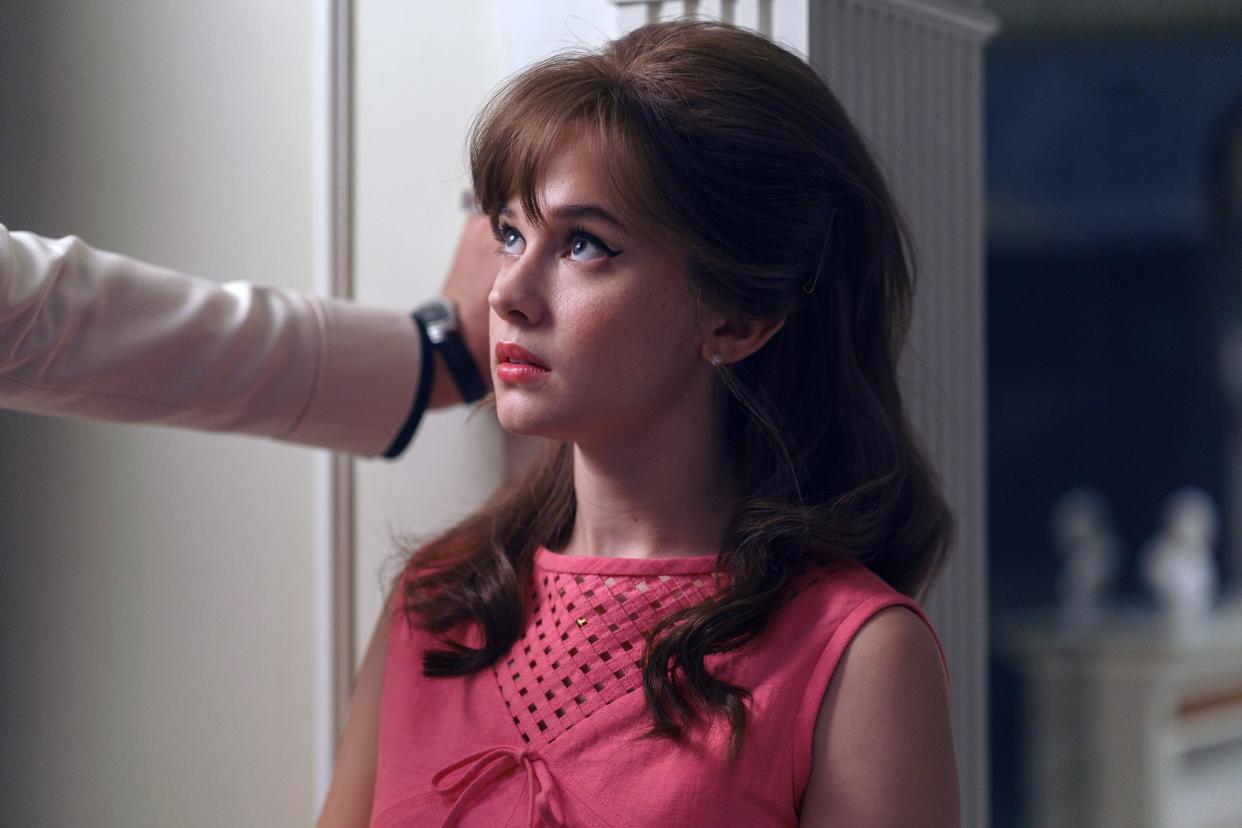
A few months ago, Elizabeth Kaiden and Nitza Wilon from The Writers Lab approached me with a simple question: “What percentage of movies are written by women over the age of 40?”
The Writers Lab is an organization set up specifically to nurture the talent of female screenwriters over the age of 40, via workshops, labs, and advocacy. They describe their mission as being to “amplify the voices of women in their prime whose stories have not been told… working toward a new landscape where the female narrative is in equal proportion to the male narrative.”
More from IndieWire
A fascinating question in support of a good cause — just my kinda thing!
So I turned to the data to see what I could uncover. I looked at the age and gender of the people behind 38,803 writing credits, across 16,624 live-action fiction feature films. There is a more detailed methodology in the Notes section at the end of this article.
Let’s examine gender first, then age, and finally, the intersection of the two.
What gender are movie screenwriters?
I’ve written extensively about gender in film over the years, so I won’t go through all the details here. However, we will cover the headline figures, and there are links to deep dives later in the article.
In the 1970s, fewer than one in 10 writers were women, whereas by 2010, that had doubled to one in five. In 2022 it peaked at 25% — which means it’s still under-indexing by half when compared to the general population.
It’s good to see a rise over time, but it’s troubling that it’s such a slow one.
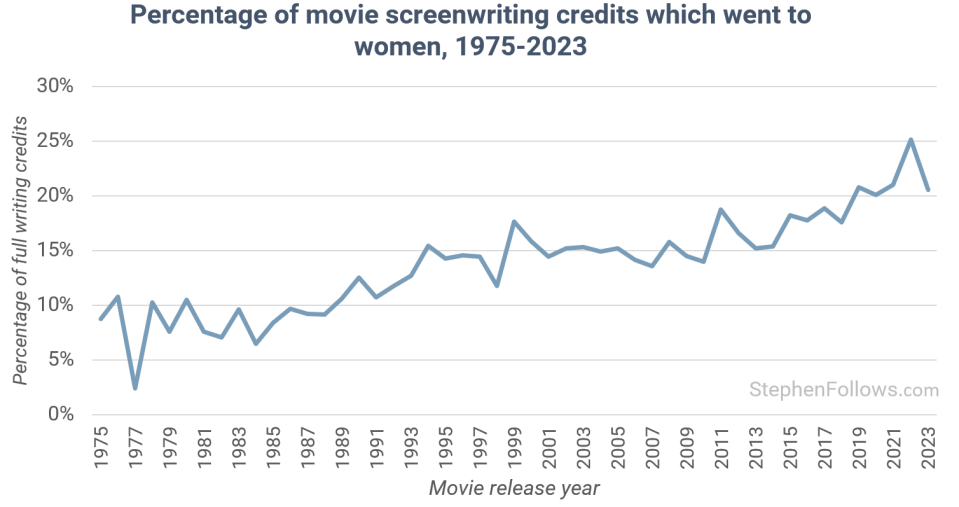
How old are movie screenwriters?
I used public sources to discover the date of birth for as many writers as I could, and I ended up with data for about 70% of screenwriting credits.
During the 20th century, the average age of screenwriters was fairly constant, at around 44. However, after about 2005, it started to rise, going from 43.3 to 50.4 by 2023.
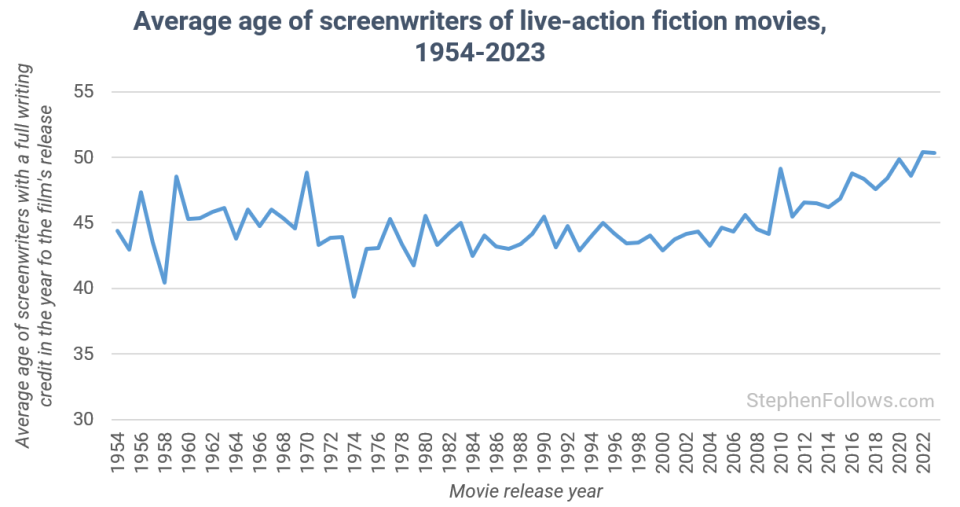
How many screenwriters are over 40 years old?
Today’s question was about writers who were 40 or older. Although any age we select to study will be arbitrary, 40 years old has a certain neatness to it. The median age of the UK population is 40, and culturally 40 is often considered a milestone or watershed age.
Jerry Seinfeld quipped, “Forty is when you finally get your head together and your body starts falling apart. Forty to sixty, I would say, is your prime. That’s when you know the most, you’ve seen the most, you understand the most, and you still have some physical energy.”
A big driver of the increase in the average age of writers was the increase in hiring of people over 40. For most of the period I studied, those over 40 accounted for between 50% and 60% of writers, whereas by 2023, that had ballooned to 78.4% of credits.
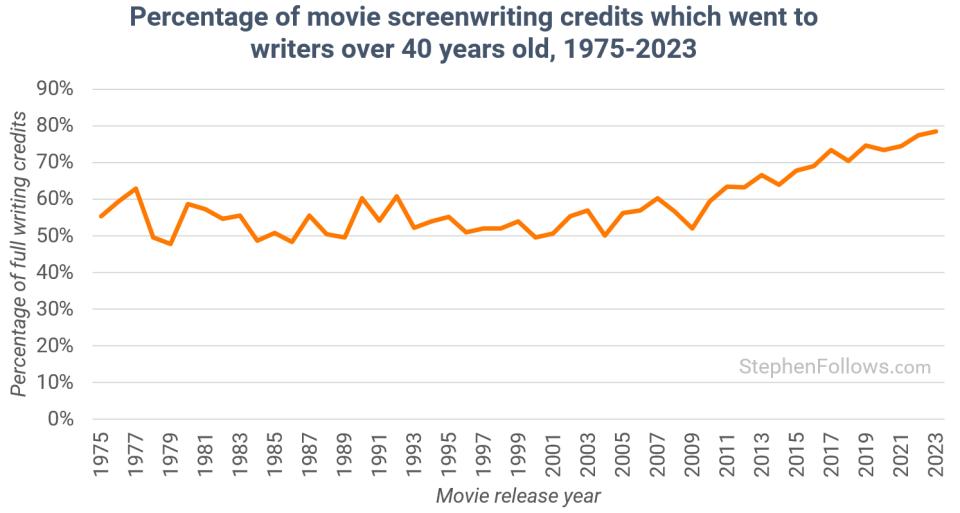
How do age and gender intersect among movie screenwriters?
So we know that most writers are men, and also most writers are over 40. But how do those two facts intersect? And how have things changed over time?
The average age of women screenwriters has been lower than that of men for almost all years I studied. This was still true in 2023, when the average women screenwriter was 46.7 years old and the average man was 51.3.
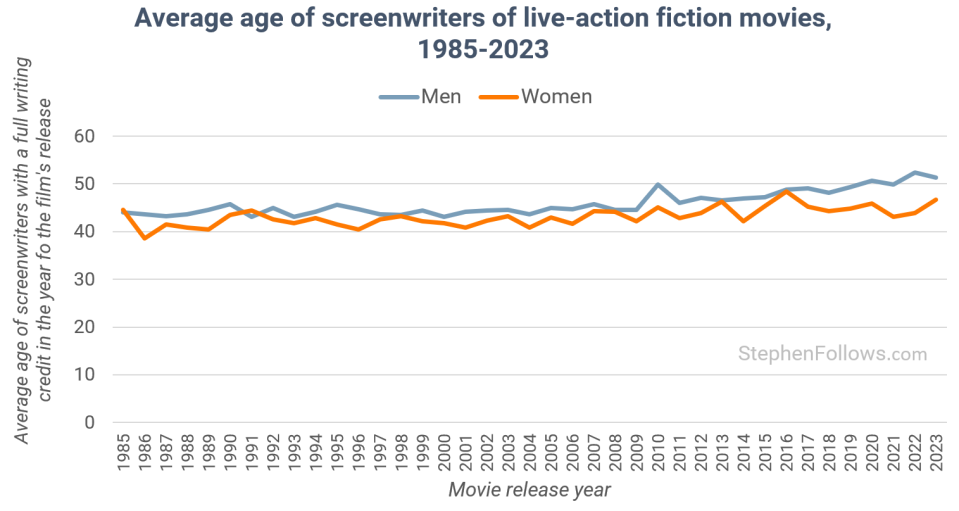
When we divide age and gender, we see that the most dramatic changes have been among men under 40. In 2000, they accounted for 43.6% of screenwriter credits, whereas by 2023, that had plummeted to just 14.4%.
The biggest constituency to gain from the reduced employment of younger men was… older men!
Over that same period, the share of screenwriting credits going to men over 40 years old increased from 42.8% to 66.0%.
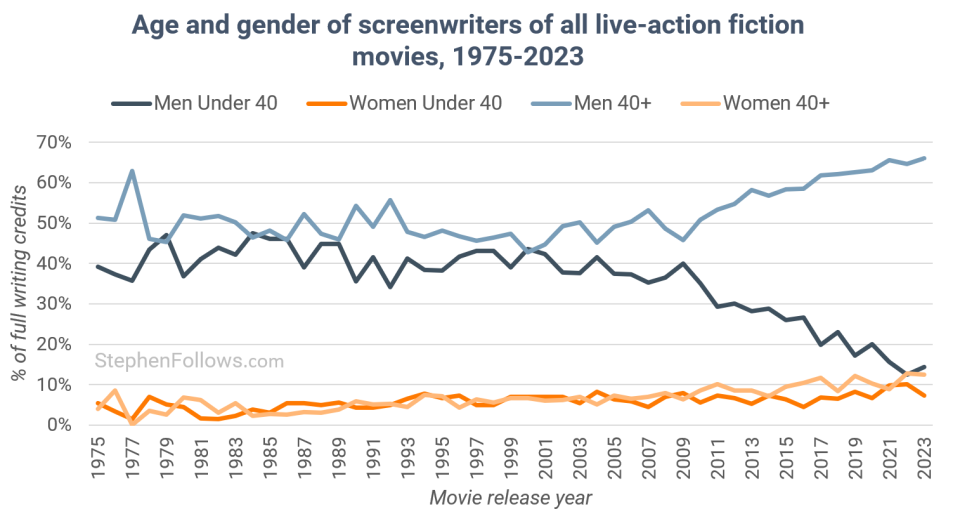
I thought it might be easier to split the same data we have above into four separate charts. Firstly, the men.
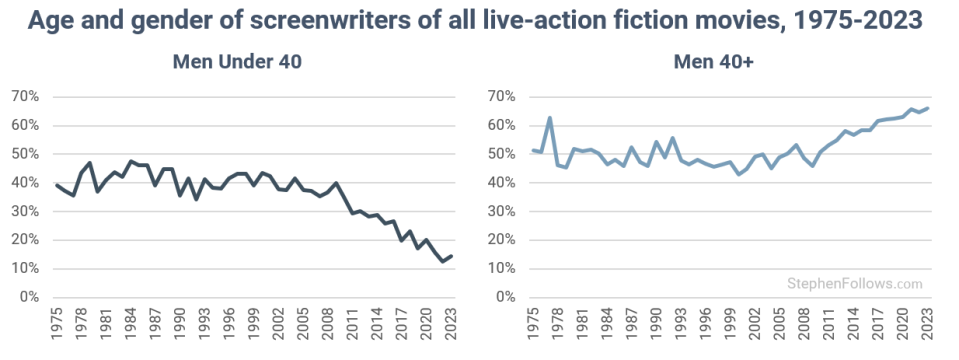
And now the women. We have to zoom in on the vertical axis, as the figures are a lot smaller than they were for men.
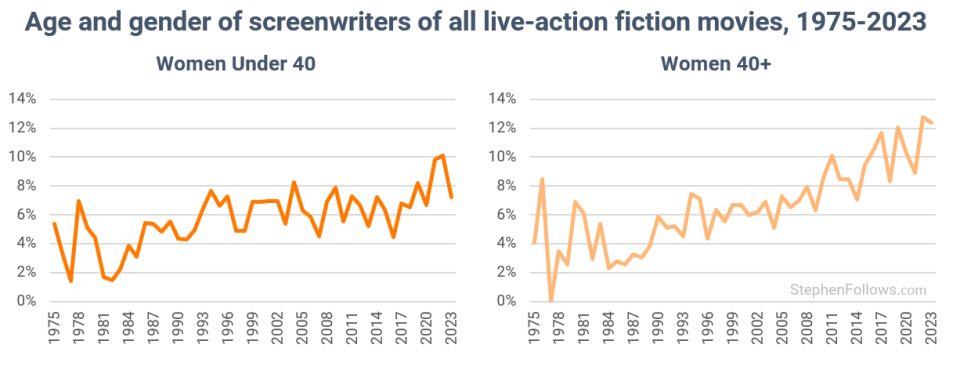
So, in answer to our original question, in 2023, 12.4% of screenplay credits went to women over 40. That’s up from a few percentage points at the tail end of the 20th century, but still far below the representation in the real world.
Why representation matters
It’s fantastic to see the rise of older women screenwriters, especially as they were pretty much absent during the 20th century. Yet older women still make up a smaller percentage of working screenwriters than the general population.
This raises a number of key questions:
Who gets to craft the stories we watch? Women over 40 bring unique life experiences, perspectives, and insights that significantly enrich storytelling, providing narratives that reflect a broader spectrum of human experiences and maturity.
Who gets to see their lives reflected on-screen? Stories told by women over 40 resonate with a significant portion of the audience, offering relatable and authentic representations and ensuring that the voices of older women are heard and valued.
Is everyone getting the support they need to become a writer? Prominent female writers over 40 can serve as mentors and role models for younger generations, paving the way for greater inspiration and aspiration among emerging women writers.
Have we built a fair and equitable working environment for everyone? Correct representation contributes to a healthier, more balanced industry where talent is recognized across all demographics. It helps combat ageism and gender bias, fostering a fairer creative environment.
Do the stories told in the movie reflect all of the human experience? We need to ensure that all types of people get a platform to discuss real-world challenges and triumphs, including themes unlikely to be fully covered by very young writers, such as aging, career changes, and family dynamics.
Notes
Today’s research started by looking at 38,803 writing credits across 16,624 live-action fiction feature films released between 1955 and 2023 and that grossed at least $1 at the US Box Office. In some of the charts, I narrowed the time period as there were far fewer films, and outliers played a much bigger role.
I narrowed in on what I named ‘Full writing credits’, which looks at primary screenwriting roles such as ‘screenwriter’, ‘scriptwriter’, or ‘written by’ etc. It excludes writing credits for those only credited as the author of the source material or who received a credit due to their work on another piece of work (i.e. using characters from the previous movie).
30,431 of the writing credits passed this threshold. It’s worth noting that all writing credits are valid—I just wanted to focus on the kind of credits that best reflect the industry’s hiring practices, and so including William Shakespeare or Charles Dickens as screenwriters would not be germane.
The data for this study came from public sources such as IMDb, OMDb, Wikipedia, Google, The-Numbers, and the actors’ own sites. Overall, I was able to determine the age and gender of 66.9% of writing credits. This will likely skew towards the more famous and frequently hired writers.
Gender was determined by pronouns in biographies, online classifications (e.g. some movie databases split ‘actors’ and ‘actresses’) and my past work on gender. I have split the gender stats into two categories (e.g. ‘men’ and ‘women’) as this reflects the way data has been captured over the period I studied. In the future, there may be more nuanced databases which capture gender fluidity and non-binary identities, but until then, we’re left with a rather crude binary approach. I used the gender the person currently publicly identifies as. I am always looking for better and more detailed ways to study and report on gender. If you think I can do better, reach out and we can chat.
The age studied is that of the writer at the time of the film’s release, which means that it won’t precisely align with the age of the writer during the scriptwriting process. You can read more about how long films take to reach the big screen here.
Stephen Follows is an established data researcher in the film industry whose work has been featured in the New York Times, The Times, The Telegraph, The Guardian, The Daily Mail, The Mirror, The Evening Standard, Newsweek, The New Statesman, AV Club and IndieWire. He acted as an industry consultant and guest on the BBC Radio 4 series The Business of Film, which was topped the iTunes podcast chart, and has consulted for a wide variety of clients, including the Smithsonian in Washington.
Best of IndieWire
The Best Father and Son Films: 'The Tree of Life,' 'The Lion King,' 'Nowhere Special,' and More
The 51 Best Sexy Movies of the 21st Century, from 'Spring Breakers' to 'X'
The 14 Best Thrillers Streaming on Netflix in June, from 'Fair Play' to 'Emily the Criminal'
Sign up for Indiewire's Newsletter. For the latest news, follow us on Facebook, Twitter, and Instagram.

 Yahoo News
Yahoo News 
